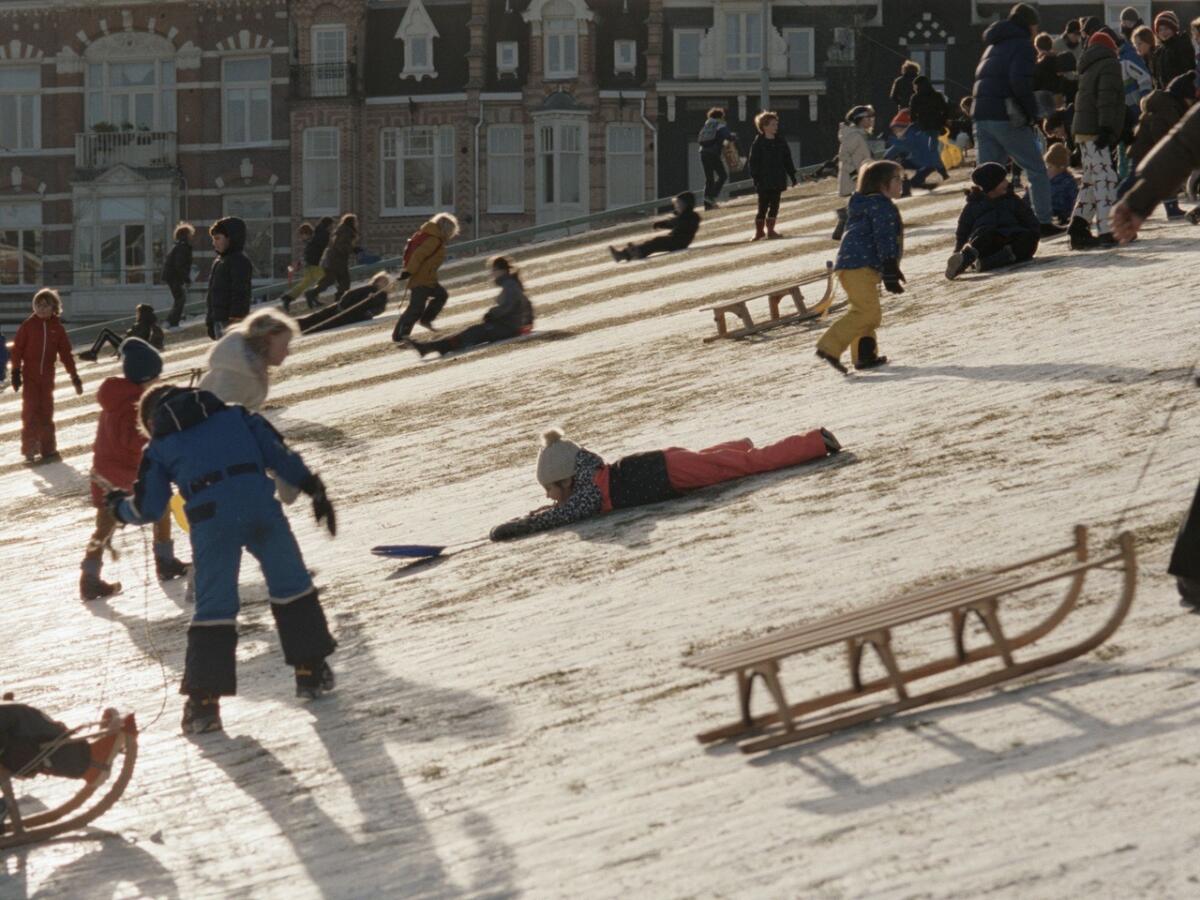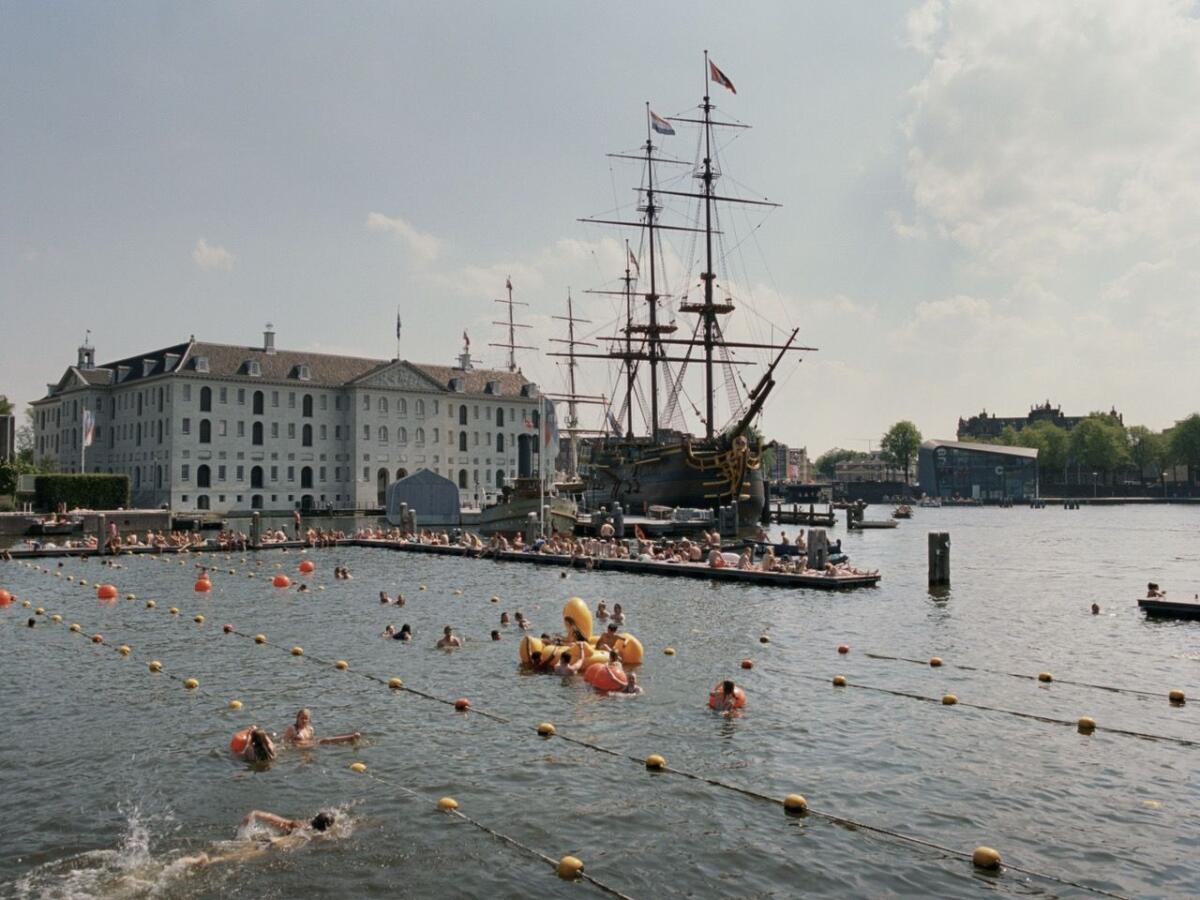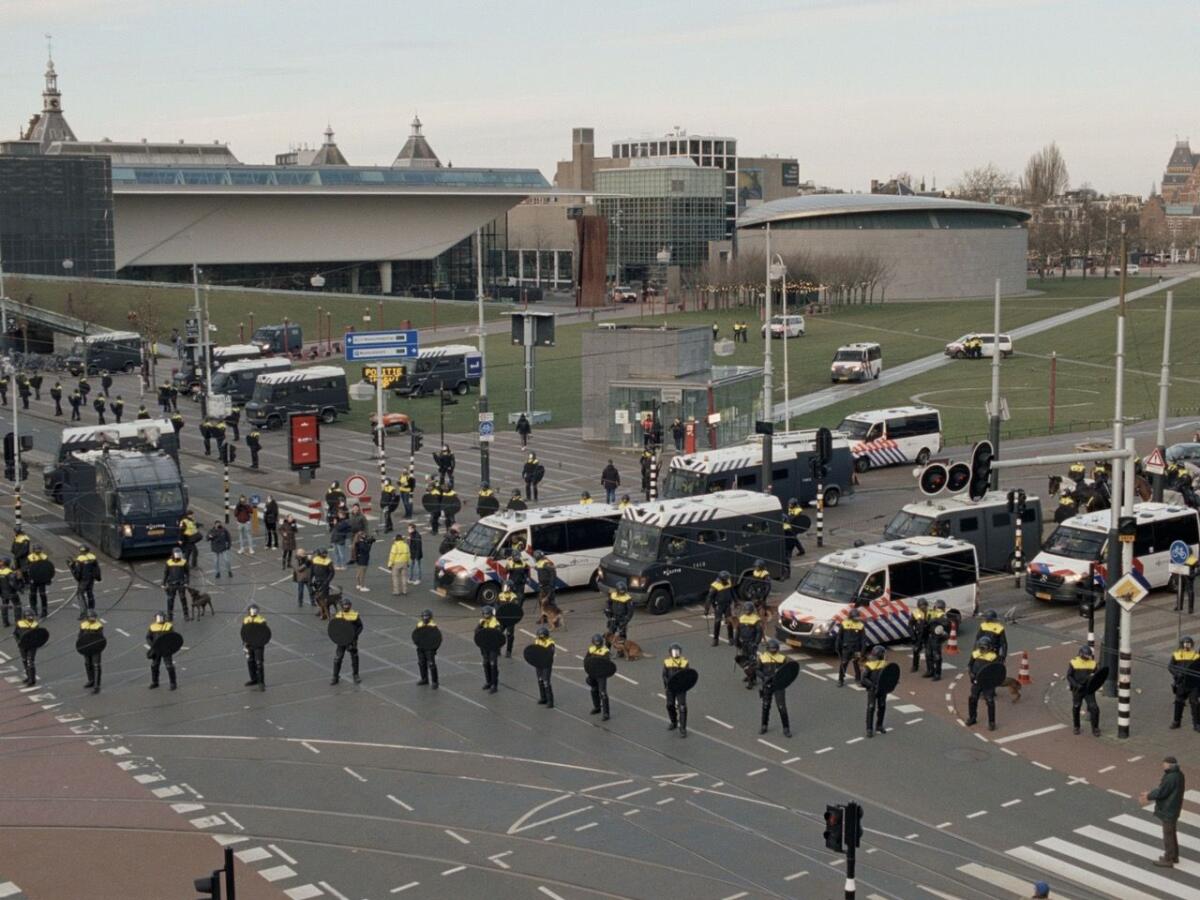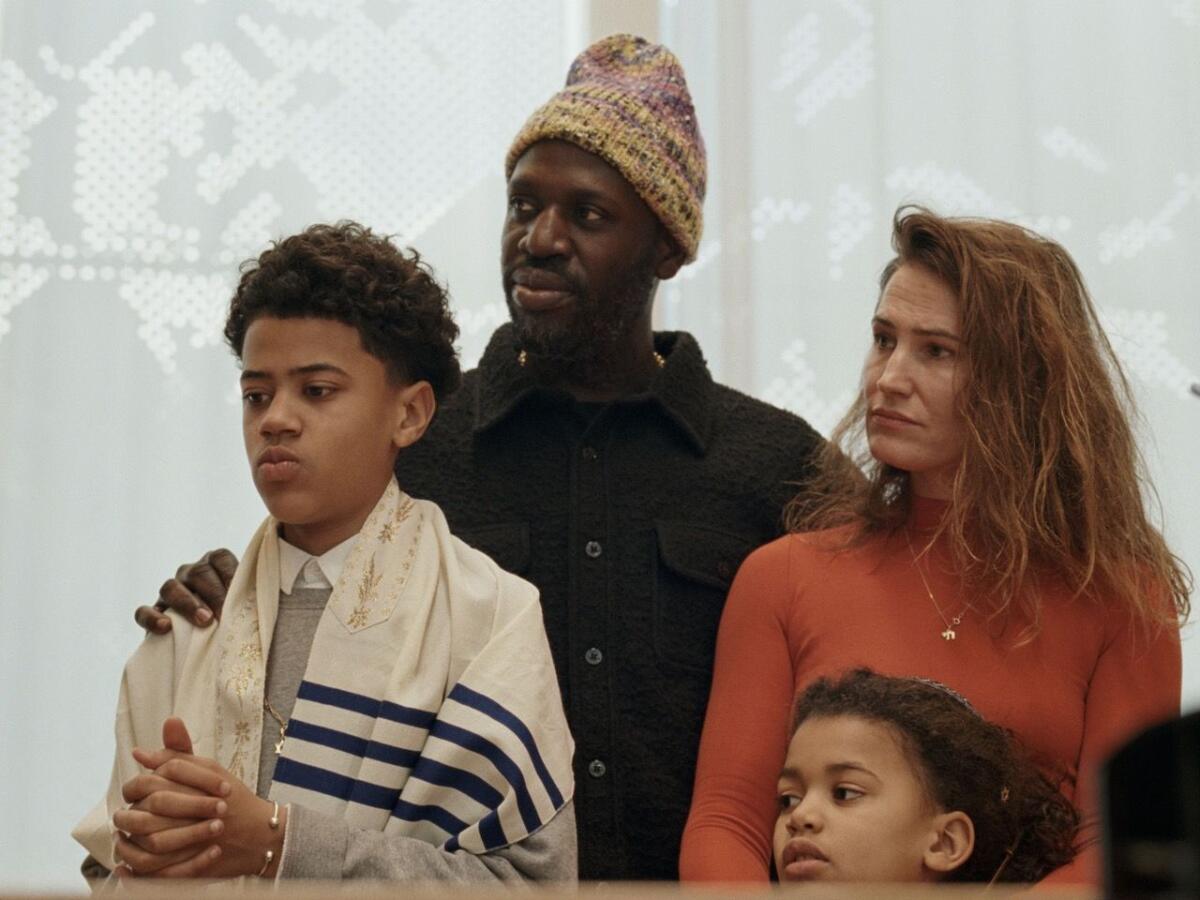Review: Steve McQueen’s ‘Occupied City’ is a masterful panorama of WWII-era Amsterdam

One of the many stories we hear in “Occupied City,” Steve McQueen’s quietly staggering new documentary, charts the fate of an Amsterdam arts establishment during the German occupation. In 1941, the Hollandsche Schouwburg, or Dutch Theater, was renamed the Joodse Schouwburg, or Jewish Theater; only Jewish artists were allowed to perform there, and only for Jewish audiences. In 1942, the Nazis turned it into a deportation center and holding prison from which thousands of Dutch Jews were shipped to the Westerbork transit camp, then on to their deaths at extermination centers including Auschwitz and Sobibor.
All of this is explained in calm, lucid narration by the English actor Melanie Hyams, who, here and elsewhere, starts with one location and then branches out into a series of succinct yet richly detailed digressions. She tells us about the average detention time at the theater, about the Jews who jumped from a balcony to their deaths. But she also tells us about the daring escapes that took place, and about the Jewish resisters who at one point tried to burn the theater down. Patiently and with great purpose, Hyams lays out how an institution built in the 19th century became a makeshift ghetto, a site of mass murder, a place of uprising and, finally, under the auspices of the Jewish Historical Museum, a lasting memorial.
“Occupied City” is also something of a memorial, and so, too, is Amsterdam itself — an idea that McQueen and his chief collaborator, the Dutch-born writer and filmmaker Bianca Stigter (“Three Minutes: A Lengthening”), emphasize in every frame. Over a densely packed, entirely gripping 4½ hours (including a 15-minute intermission), they lead us on a visual tour of the city in the present day, guiding us down streets, over bridges, across parks and into homes, restaurants, offices and nightclubs. (McQueen and Stigter, who are married, make their home in Amsterdam.) The movie is structured not chronologically or even thematically, but geographically; we are introduced to each of the movie’s 130 locations with an exact address, followed by a verbal account of what is known to have befallen the Jews who may have once lived, worked or played there. Often she notes that the building in question was “demolished,” a word that reminds us of the terrible truths that lie hidden beneath the foundations and facades of the modern metropolis.

Crucially — and with a restraint that builds in power as the movie progresses — McQueen never shows us archival footage from the 1940s or any historical reenactments. Instead he depends entirely on Hyams’ narration to lead us into the past, a formal choice that underscores how tenuous and even invisible our connections to that past can be. It takes close attention to perceive those connections, and “Occupied City,” beautifully shot (by Lennert Hillege) and ingeniously edited (by Xander Nijsten), is predicated on a striking disjunction between then and now, and between sound and image. You want to let this movie wash over you, to bask in the lovely everyday moments of smiling pedestrians, blissed-out revelers and laughing, running children. But you also want to put these scenes aside and lean forward in your seat, the better to give the individual tragedies being recounted the time and attention they deserve.
But the film doesn’t linger, and Hyams’ unceasing narration, distilled from Stigter’s 2019 book “Atlas of an Occupied City (Amsterdam 1940-1945),” moves with a briskness that conveys scope without sacrificing gravity. The aesthetic tension that McQueen sustains here, far from pulling you out of the movie, proves extraordinarily productive. The contrasts can verge on the surreal: It’s jarring to see what has become of a former Jewish ice cream parlor, or to watch a bride and groom pose for photos at what was once a hospital for Dutch soldiers. At one point, the camera lingers on an event highlighting the histories of Black people descended from Aruba, Curacao and Suriname, an instructive reminder that the Netherlands has been the occupier as well as the occupied.
Sometimes the links are more subtly intuitive. Over a few simple shots of an outdoor café, the narrator describes the food shortages that ravaged Amsterdam during the so-called Hunger Winter of 1944, a tragedy to which she keeps returning. And then there are the newly shot images of children playing in class, which provide a devastating counterpoint to Hyams’ account of the schools where Jewish children were segregated during the occupation. Those class sizes steadily dwindled until the schools finally closed in 1943, the year when the last Dutch Jews were deported and Nazis triumphantly declared Amsterdam to be “free of Jews.”

If this all sounds perilously abstract, the effect is precisely the opposite. The achievement of “Occupied City” is to give texture, definition and specificity to events that have too often been glossed over in movies, with their broad brushstrokes and atrocity shorthand. It’s common to describe such events as unspeakable or unimaginable, a cliché that McQueen rejects as forcefully here as he did in his 2013 drama “12 Years a Slave.” That movie depicted as much as “Occupied City” withholds, but the upshot in both films is a sense that history has been unflinchingly and powerfully confronted. For those willing to watch and listen, the worst can indeed be spoken, imagined and on some level understood.
In “Occupied City,” McQueen reminds us that the Nazi death machine was an apparatus in which thudding bureaucratic banality collided with startlingly imaginative cruelty. You may not flinch when you hear, for the umpteenth time, about a round of mass executions, but a throwaway line kicks you in the gut: “The wives of the executed men could collect their wedding rings here the next day.” The movie has an especially sharp ear for lesser-reported tragedies: the boy who was shot to death because he was caught outdoors two minutes after curfew; the runner who was arrested and deported because he forgot that Jews were forbidden in a particular park; the desperate residents killed for chopping down trees to use for firewood during the long, cold, resource-depleted Hunger Winter.
But if “Occupied City” is an account of barbarism in a country that saw about 75% of its Jewish population murdered during the Holocaust, it is also, stirringly, a chronicle of mass resistance. Street after nondescript-looking street testifies to the courage of those Dutch residents who risked their lives: the many men and women who sheltered Jews in guesthouses and secret rooms. Inevitably, the movie touches on Anne Frank, though not as often as you might expect, It’s as if McQueen and Stigter didn’t want the Holocaust’s most iconic victim to overshadow the countless others who suffered in relative anonymity.

If resistance is one of the movie’s key themes, it’s willing to push that theme to sometimes provocative ends. McQueen began filming in 2019, and much of the footage was shot during the first outbreak of COVID-19, a context that produces some queasy juxtapositions. The first time I watched “Occupied City,” shortly before its premiere at Cannes last May, I initially wondered if McQueen were drawing a facile comparison between Jewish resisters during World War II and a group of unmasked protesters we see gathering during the early days of the pandemic. A haunting sequence of an eerily depopulated Amsterdam at night, accompanied by Oliver Coates’ brooding string score, couldn’t possibly be likening Nazi-imposed curfews to COVID lockdown restrictions, could it?
But long before the movie ended, I concluded no, and not just because McQueen’s interest in the pandemic — he soon shows us Amsterdam residents receiving their first COVID vaccines — seems more observational than analytical. He’s fascinated in general by images of people gathering together in protest, whether it’s a crowd gathered at an antifascist rally or a group of activists waving Palestinian flags in Dam Square, a place of enormous historical significance: Here, Hyams tells us, two days after the Nazis surrendered in 1945, German soldiers fired into a crowd of Dutch revelers celebrating what they thought was the end.
What “Occupied City” leaves us with, in these moments when past leans into the present, is an understanding that to gather in public, for any reason, is to practice a social freedom that was hard won and almost destroyed. To that end, McQueen and Stigter haven’t just excavated some not-so-ancient history; they’ve also made a haunting, magisterial tribute to a city they clearly love.
'Occupied City'
(In English and Dutch with English subtitles)
Rating: PG-13, for thematic material, strong language and sexual material, smoking and brief drug use
Running time: 4 hours, 30 minutes
Playing: Starts Friday at Landmark’s Nuart Theatre, West Los Angeles
More to Read
Only good movies
Get the Indie Focus newsletter, Mark Olsen's weekly guide to the world of cinema.
You may occasionally receive promotional content from the Los Angeles Times.











